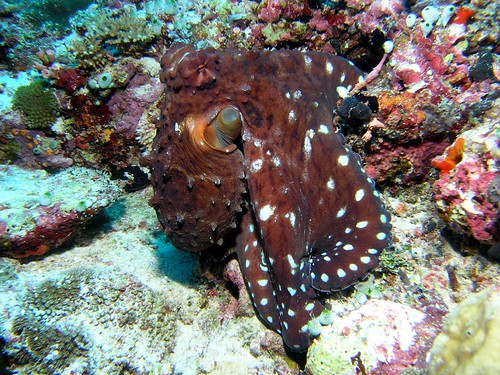Enjoy this nicely narrated video of the Cyanea Octopus changing color and feeding:
Remember to "Follow" Everything Octopus and enter the Cephalopodmas Contest!
Eight arms, three hearts, and endless capabilities! Cephalophiles, dwellers of the deep, and lovers of all things absurd, join us as we explore and celebrate everything octopus!
Search Everything Octopus
Showing posts with label Cyanea Octopus. Show all posts
Showing posts with label Cyanea Octopus. Show all posts
Wednesday, December 9, 2009
Saturday, January 17, 2009
Funny Cyanea Octopus vs. Egret Video
The Cyanea Octopus seems to like its solitary life, and will use its unique ink power to keep it that way!
Watch what this sneaky Cyanea Octopus does to keep the moseying Egret out of its territory.
Wednesday, January 14, 2009
Sexual Cannibalism Documented Among Cyanea Octopuses
From: Informaworld.com, March 2008
Written By: Roger T. Hanlon and John W. Forsythe
Sexual cannibalism is rare in the animal kingdom. Although cannibalism is not uncommon in cephalopods, here we report the first documented case of sexual cannibalism. A large female Octopus cyanea was observed continuously for 2.5 days in Palau, Micronesia, when she was out of her den. On the second day, a small male followed and mated her 13 times during 3.5 hours while she continued to forage over 70 m distance. After the 12th mating, she aggressively chased a different small octopus that barely escaped by jetting, inking and swimming upwards. Shortly thereafter, the original small male mated her a 13th time, but subsequently she attacked and suffocated him and spent 2 days cannibalizing him in her den. This sort of intraspecific aggression helps to explain several reports of octopuses mating out in the open, a behaviour that may serve to allow the smaller mate to escape cannibalism.

Talk about a "maneater"!
Written By: Roger T. Hanlon and John W. Forsythe
Sexual cannibalism is rare in the animal kingdom. Although cannibalism is not uncommon in cephalopods, here we report the first documented case of sexual cannibalism. A large female Octopus cyanea was observed continuously for 2.5 days in Palau, Micronesia, when she was out of her den. On the second day, a small male followed and mated her 13 times during 3.5 hours while she continued to forage over 70 m distance. After the 12th mating, she aggressively chased a different small octopus that barely escaped by jetting, inking and swimming upwards. Shortly thereafter, the original small male mated her a 13th time, but subsequently she attacked and suffocated him and spent 2 days cannibalizing him in her den. This sort of intraspecific aggression helps to explain several reports of octopuses mating out in the open, a behaviour that may serve to allow the smaller mate to escape cannibalism.

Tuesday, January 6, 2009
Species: Cyanea Octopus, Part II
Here are more fascinating facts about the Cyanea Octopus:

- Unlike most octopuses, the Cyanea Octopus feeds during daylight hours. Its prey includes fish, crabs, shrimp and bivalve mollusks such as clams, oysters, and scallops.
- Camouflage is not only a handy tool for the Cyanea Octopus, it is also a necessary survival tool, as this octopus is preyed upon by sharks, moray eels, and Hawaiian monk seals.
- Courtship behavior of the Day octopus begins as the male displays coloring of dark brown with white spots and slowly approaches the female, who is typically in full camouflage. Males have a long modified third right arm that they hold in an upright coiled position and wave toward the female. If the female is receptive to the signaling male, he inserts his arm into the female's oviducts to pass spermatophores from arm's length.
- The male may keep his distance to avoid the risk of being eaten by the female, a behavior that has been observed in the wild after mating.
- Female Cyanea Otopuses lay their eggs strategically in a hard-to-reach space within their lairs. Once the eggs hatch into planktonic juveniles, they feed on zooplankton during the early stages of development.

Labels:
Cyanea Octopus,
Indian Ocean,
Mating,
Pacific Ocean,
Species
Saturday, January 3, 2009
Species: Cyanea Octopus, Part I

The Cyanea Octopus, otherwise known as the Day Octopus or Big Blue Octopus, is a fascinating little creature! here are some key facts about the Cyanea Octopus:
- The Cyanea Octopus can be found in both the Pacific Ocean and Indian Ocean from Hawaii to the eastern coast of Africa.
- This cephalopod growsto have a body approximately 16 cm and arms at least 80 cm.
- When at rest, the Cyanea Octopus is brown in color, however they have the ability to rapidly change the color and texture of their skin to blend into their surroundings as a defense mechanism.
- A characteristic feature of the Cyanea Octopus is their dark oval false-eye spots. These spots are present at the base of its arms and on the tips of its arms along with 2 rows of lighter spots. The dark eye-spots are only sometimes visible, as this octopus can change its appearance at will.
- Cyanea Octopuses feed in daylight hours. Because of this, their camouflage skills are considered "exceptional" among the many species of octopuses.
- The Cyanea octopus's complex brain sends nervous impulses to their muscles causing them to change appearances almost instantly as they move over sand, coral, rubble and other surfaces. One Day octopus was observed by octopus biologist Roger Hanlon changing patterns 1,000 times over a 7 hour period off the coast of Hawaii!
- This octopus excavates lairs in coral reefs and associated rubble which can be located by identifying "middens" outside the lair entrance which are typically the empty shells of bivalves and crabs which it has preyed upon.
Labels:
Cyanea Octopus,
Indian Ocean,
Pacific Ocean,
Species
Subscribe to:
Posts (Atom)